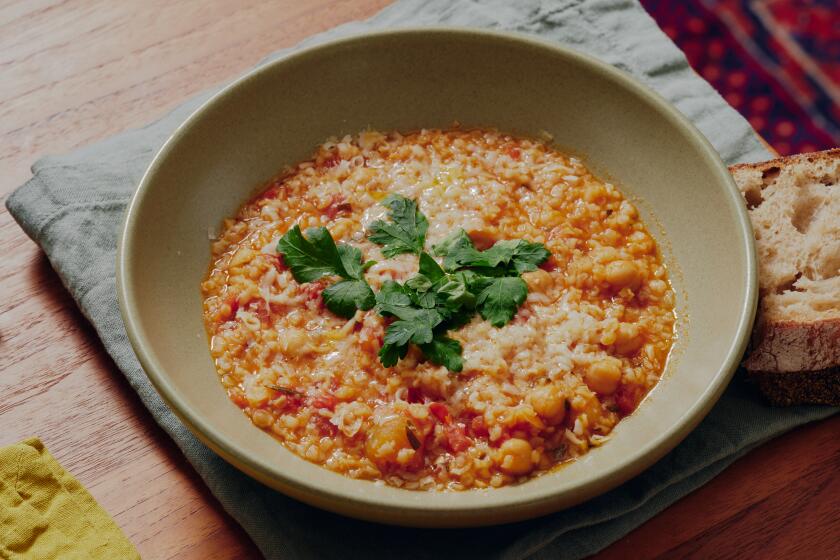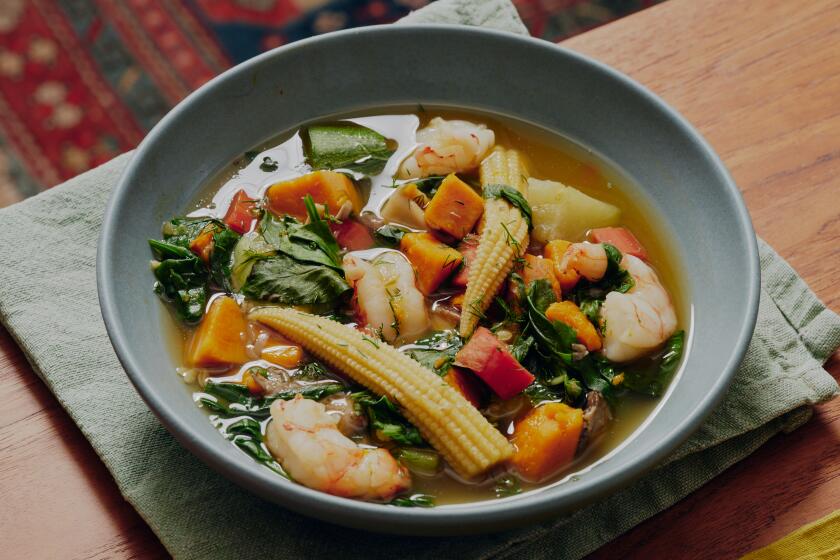Vichyssoise
- Share via
Unless you hate to dance, how could you resist a recipe that promises to “make you click your heels and shout ole”?
This lively claim for Spanish-style baked fish appeared in a little book called “Chicken Soup to Nuts” produced by the Sisterhood of Temple Beth Hillel in North Hollywood. There’s no publication date, but the book sold for $3.50, which indicates that it was released a long time ago.
Paging through old cookbooks published by women’s organizations is more fun than reading novels. Along with recipes, they offer tender memories of families and friends, historical insights, unassuming humor, inspirational tidbits, practical advice--even poetry.
It’s like peeping into other people’s lives, at least the parts of their lives that revolved around the kitchen and dining room. The bonus is access to treasured family recipes, set down in print for what was probably the first and only time.
Think of the traditions represented by Old Aunt’s Cookies, Grandmother’s Chocolate Cake, Aunt Jessie’s Boiled Salad Dressing, Grace’s Wedding Cake and Mother Hughes’ English Mincemeat.
You can almost smell the aroma of baking bread while reading Kia Lund’s recollections of baking day in Kodiak, Alaska. In “Joys of Ethnic Cooking,” an undated book from the Los Angeles Orthodox Club, she wrote: “In Alaska we did things from scratch, and our kitchen smelled so good from the beginning of the yeast until the last smell of fresh baked bread went out the window.”
In that same book, Raisa N. Baldwin of Glendale praised Aunt Kia’s rhubarb crisp. Could that have been the same Kia? Baldwin also contributed an invigorating tea and Bourbon punch. “When my husband was stationed in England during World War II, a general gave him this recipe to warm up his men after their long flights,” she wrote. One can picture the exhausted pilots returning from harrowing missions to a bracing cup of this brew.
The Orthodox Club was linked to the Holy Virgin Mary Russian Orthodox Cathedral, and its cookbook contained what purported to be an orthodox recipe for beef stroganoff. The secret was to soak the meat overnight in Port.
“From Noodles to Strudels,” published by the Beverly Hills chapter of Hadassah in 1972, provided a venue for an unnamed limerick writer. A recipe for a simple quiche made with white bread, processed American cheese, eggs, milk and butter started with this ditty:
“It was my turn to bring the main dish
And I thought that this was delish--
But my dear family spied it
And of course tried it
And the pot that I brought held gornisht!”
(Gornisht is Yiddish for nothing.)
The “Pi Beta Phi Cook Book,” published by the Los Angeles Alumnae Club of Pi Beta Phi in 1936, is spattered brown throughout, showing that it had heavy use. Inside the front cover is a recipe for hot rolls, neatly written in pencil. Because everyone in that era knew how to make rolls, the instructions were simply, “Combine and beat hard.”
Older books sometimes listed ingredients in terms of price rather than quantity. To make Leta Schreiber Gosden’s Christmas salad from the Pi Beta Phi book, you needed 10 cents worth of cinnamon candies. These were boiled with sugar and water to make a spicy red syrup for poaching whole peeled apples. The apples were then stuffed with cream cheese and nuts.
Earlier books usually included housekeeping and cooking tips. “A little cooked tapioca will keep your souffles plump,” advised the Santa Barbara Junior League Cook Book published in 1939. “Did you ever try 1/2 teaspoon baking powder in your mashed potatoes?” asked the Philathea Cook Book compiled by the Philathea Class of First Methodist Episcopal Church in Santa Barbara in 1928. (The consequences of adding the baking powder were not revealed.)
“Don’t know why it is, but any dried bean dish with a dash of vinegar eliminates any . . . um . . . after effects,” appeared with a lentil soup recipe in “Hot or Cold, It Goes Out in the Morning,” compiled by the St. Martin of Tours Women’s Council. The soup included two tablespoons of wine vinegar.
Many of the books, including this one, omit a publication date, as if the compilers felt their work had no historical significance. Sometimes women’s fashions in sketches that illustrate a book offer a clue to its era. “Sharing Recipes” from the Sisterhood of Kehillath Israel Jewish Congregation of Pacific Palisades contains a 10-year Jewish holiday calendar that starts in 1982, indicating that it must have been published in the early ‘80s.
However, dates are plentiful in “The San Diego 200th Anniversary Cook Book” organized by the Del Cerro Junior Woman’s Club. Although the book was published in 1969, the recipes go back much further.
Ida Nasatir wrote about a fruited beef dish served to her family in Santa Ana “when cows roamed the now busy urban streets.” Mrs. Lyndon H. Osmundson explained that her meatball recipe “has been in our family since the ‘Good Old Days’ when we had ice delivered twice a week for our ice box.”
Edith Westmoreland provided an interesting literary note about lamb stew. She wrote: “At sheep-shearing time, on the ranch in San Diego County where Helen Hunt Jackson was staying gathering material for her book ‘Ramona,’ they made a stew enjoyed by the family, guests, ranch hands and sheep-shearers alike. A stew so delicious, she included it in her book.” Westmoreland gave two versions of the stew, one concocted by her mother, the other her own.
Cookbooks such as these were usually sold through the organizations that compiled them and not in bookstores. Most vanished within a few years of publication. Places to find them today are used bookstores; thrift shops; garage, rummage and library sales; and the catalogs of specialists who deal in antiquarian cookbooks. The rewards are twofold: good home cooking and a good read.
Saute leeks and onion in butter in large pot over medium heat until softened but not browned, 10 to 12 minutes.
Add potatoes, broth, salt and cayenne. Cover and simmer gently until potatoes are tender, 30 to 45 minutes. Process through food mill or press through fine strainer using wooden spoon, forcing as much vegetable pulp through as possible.
Cool to room temperature; add cream. Chill several hours or overnight. When ready to serve, garnish with finely chopped chives.
Get our Cooking newsletter
Get a taste of Los Angeles — and the world — with recipes and kitchen tricks from the L.A. Times’ Cooking newsletter.
You may occasionally receive promotional content from the Los Angeles Times.















